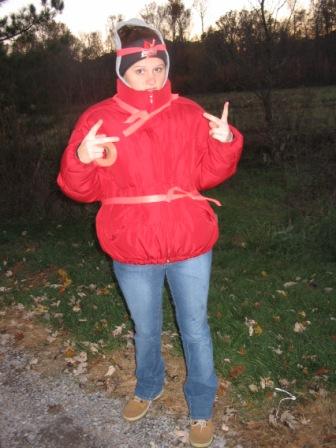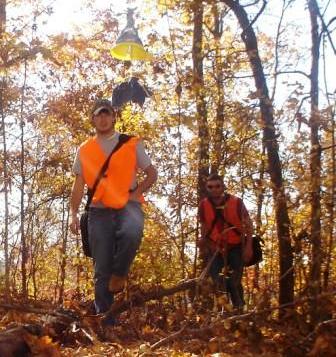| Mammal
Abstracts 2007 The
Use of Game Camera and Scent Attractants as a Mammalian Species Index
on Clark's River Refuge
<>Does reflective tape affect trapping success with small Sherman live traps? Emily Pollom and John Gorey  Searching
for mammal traps at night can be difficult. Time spent searching may
mean more
time in traps for animals. Reflective tape can assist in finding traps
at night
which would eliminate stress to the animal as well as money spent to replace
lost traps. We used 120 traps in three locations to test the effect of
reflective tape on trapping success. Sixty traps were set in an over-grown
field and sixty were set in two wooded areas. Of these, sixty were
marked with reflective tape
in one of three strategic locations. These small Sherman Live Traps
were baited
with a mixture of peanut butter and oats. Traps were left out for four
days and
checked three times daily. A Chi-square homogenaity tests was run and
it was
found that reflective tape has no significant effect on trapping
success. The
same test was used to determine if, amongst the tape types there was a
significant difference. Tape near the back door had a significantly
lower
capture rate than traps with tape in the other two locations. Searching
for mammal traps at night can be difficult. Time spent searching may
mean more
time in traps for animals. Reflective tape can assist in finding traps
at night
which would eliminate stress to the animal as well as money spent to replace
lost traps. We used 120 traps in three locations to test the effect of
reflective tape on trapping success. Sixty traps were set in an over-grown
field and sixty were set in two wooded areas. Of these, sixty were
marked with reflective tape
in one of three strategic locations. These small Sherman Live Traps
were baited
with a mixture of peanut butter and oats. Traps were left out for four
days and
checked three times daily. A Chi-square homogenaity tests was run and
it was
found that reflective tape has no significant effect on trapping
success. The
same test was used to determine if, amongst the tape types there was a
significant difference. Tape near the back door had a significantly
lower
capture rate than traps with tape in the other two locations.Animal Species Prone to Automobile Fatality Along the Trace BJ Riden and Matt Dennis   Road kill sampling of large
geographic areas has been widely used and accepted for biologists. Road
kill
surveys are used as indicators of local population densities over
time.
A road kill survey was conducted on the Trace
in Land Between the Lakes between 13:00 and 15:00 every Wednesday and
Sunday
from October 14 to November 14, 2007. We
predicted that Didelphis
virginiana
would be the most observed road kill due to its local abundance,
personal
observations, and more easily spotted body size
Thirteen specimens of mammals
were collected, with Sciurus
carolinensis
being the most abundant with six specimens. A road kill index was
calculated by
dividing the number of road mortalities for each species by the
distance of the
sample route (Gehrt 2002). Road kill sampling of large
geographic areas has been widely used and accepted for biologists. Road
kill
surveys are used as indicators of local population densities over
time.
A road kill survey was conducted on the Trace
in Land Between the Lakes between 13:00 and 15:00 every Wednesday and
Sunday
from October 14 to November 14, 2007. We
predicted that Didelphis
virginiana
would be the most observed road kill due to its local abundance,
personal
observations, and more easily spotted body size
Thirteen specimens of mammals
were collected, with Sciurus
carolinensis
being the most abundant with six specimens. A road kill index was
calculated by
dividing the number of road mortalities for each species by the
distance of the
sample route (Gehrt 2002).
Success rates between two live traps, the Tomahawk and the Havahart Aimee
Owen and McGlensey
Abiles
 In
this research project, we tested
the success rates between two types of live traps, the Tomahawk and the
Havahart. We did a random placement of 10 traps at the
first two sites and a random placement of five at each of the last two,
a total
of four sites. At In
this research project, we tested
the success rates between two types of live traps, the Tomahawk and the
Havahart. We did a random placement of 10 traps at the
first two sites and a random placement of five at each of the last two,
a total
of four sites. At each site the traps
were set in a line. All of the traps
used were relatively the same size. Each
trap was baited with pre-mixed peanut butter and tuna. All traps
were set and checked within 12
hours, although they were normally checked before that mark. Two
specimens were trapped in Tomahawk traps
(a female Eastern gray squirrel, Sciurus
carolinensis and a
female each site the traps
were set in a line. All of the traps
used were relatively the same size. Each
trap was baited with pre-mixed peanut butter and tuna. All traps
were set and checked within 12
hours, although they were normally checked before that mark. Two
specimens were trapped in Tomahawk traps
(a female Eastern gray squirrel, Sciurus
carolinensis and a
female Bait
Efficiency in Trapping for Gray
Squirrel (Sciurus carolinensis)
under Fruit Failure
Conditions James
Mayes and Robert Schaefer
 The
gray squirrel (Sciurus
carolinensis) is the
subject of many
studies and most of them involving trapping squirrels. For our
experiment we
wish to see if there is a preference in bait for the squirrels under
fruit
failure conditions, being that this year’s oak crop has been
drastically
reduced as well as other primary forage crops. We tested three baits in
total,
walnut (Juglans nigra), pecan (Carya illinoinensis), and peanut
butter (Jif® Extra Crunchy), by trapping with
the baits. After 80.08 hours of trapping, we caught 17
gray squirrels. The peanut butter traps
showed to be the least efficient, not catching any squirrels, while the
pecan
and walnut traps showed to be the best.
A chi-squared test was performed between the data obtained from the
pecan and walnut sets to find there was not a significant difference
(P-value =
0.467) between the two. Meaning that there is not a preference between
walnut
and pecan, but the squirrels clearly do not like Jif® peanut butter.
The
gray squirrel (Sciurus
carolinensis) is the
subject of many
studies and most of them involving trapping squirrels. For our
experiment we
wish to see if there is a preference in bait for the squirrels under
fruit
failure conditions, being that this year’s oak crop has been
drastically
reduced as well as other primary forage crops. We tested three baits in
total,
walnut (Juglans nigra), pecan (Carya illinoinensis), and peanut
butter (Jif® Extra Crunchy), by trapping with
the baits. After 80.08 hours of trapping, we caught 17
gray squirrels. The peanut butter traps
showed to be the least efficient, not catching any squirrels, while the
pecan
and walnut traps showed to be the best.
A chi-squared test was performed between the data obtained from the
pecan and walnut sets to find there was not a significant difference
(P-value =
0.467) between the two. Meaning that there is not a preference between
walnut
and pecan, but the squirrels clearly do not like Jif® peanut butter.
Exploratory
Behavior of Mus musculus and Peromyscus leucopus
Katie Marks and Jessica Purcell   We
expect there to a difference in the exploratory patterns of Peromyscus
leucopus and Mus musculus. Katie and I defined exploratory patterns as
the time each mouse took to reach the reward, number of turns,
backtracks,
pauses, and attempts to take shortcuts to the reward.
We selected these two species based on the
differences in their habitat. P.
leucopus primarily lives in wooded
areas or along edges. M.
musculus inhabits mostly inhabited or
uninhabited buildings, fence rows, and abandoned grain fields. In order to measure exploratory behavior, we
created a four-level, 68.6 by 68.6 centimeter maze.
The walls were interchangeable, allowing us
to create three different mazes. Six
mice of each species were tested in the various mazes.
A one-tailed T-test indicated a significant
difference between the two species in number of pauses {.04}, number of
turns
{.02}, and number of shortcuts taken {.01}. We
can attribute these results to the differing habitats
each species
occupies. We
expect there to a difference in the exploratory patterns of Peromyscus
leucopus and Mus musculus. Katie and I defined exploratory patterns as
the time each mouse took to reach the reward, number of turns,
backtracks,
pauses, and attempts to take shortcuts to the reward.
We selected these two species based on the
differences in their habitat. P.
leucopus primarily lives in wooded
areas or along edges. M.
musculus inhabits mostly inhabited or
uninhabited buildings, fence rows, and abandoned grain fields. In order to measure exploratory behavior, we
created a four-level, 68.6 by 68.6 centimeter maze.
The walls were interchangeable, allowing us
to create three different mazes. Six
mice of each species were tested in the various mazes.
A one-tailed T-test indicated a significant
difference between the two species in number of pauses {.04}, number of
turns
{.02}, and number of shortcuts taken {.01}. We
can attribute these results to the differing habitats
each species
occupies.Tree
cutting preferences in Castor canadensis Justin Moorman
|
 The
use of game cameras has been used widely in monitoring
mammals.
The
use of game cameras has been used widely in monitoring
mammals.